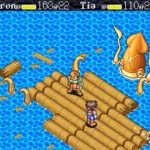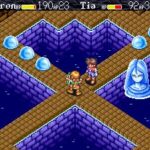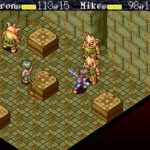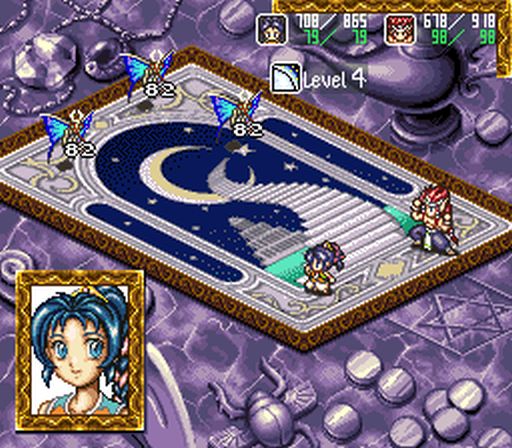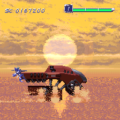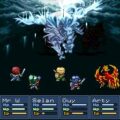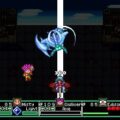Developer: Amcuss, Bits Laboratory Publisher: Pack-in-Video Release: 09/27/96 Genre: Strategy RPG
Tactical RPGs were not common during the 16-bit era. While we all have fond memories of Shining Force and if you are hardcore Ogre Battle the pickings were slim in the US. In Japan however there was an embarrassment of riches for every platform, from the PC Engine to the Super Famicom. Monstania is a cute little gem that has a low profile as it never left Japan. Thanks to fan translators everyone can enjoy this breezy game that has charming characters and tactical depth.
Monstania follows Fron, a youth living on the island of Monstania. One day while wandering in the forest he sees a mysterious light. But this is no ordinary light, it is a fairy! Fron had always wanted to see a fairy but they were long thought to be extinct. With newfound vigor Fron ventures out to find this apparent fairy alongside his girlfriend Tia. But his simple quest to find a fairy will soon become something much greater….
The overarching story in Monstania is not terribly interesting. The driving thrust of the story is weak and the game waits too long to pick up the pace. What keeps you going aside from the measured gameplay is the funny and charming characters. Fron and Tia are a great pair who have good chemistry and play off each other well. Even the primary villains, bumbling as they are manage to be entertaining. That being said this is one you could play without the fan translation and you would not miss much. I say that as someone who did not mind the plot.
Monstania is a tactical RPG but not in a strict sense. In every encounter you only control one or two characters. Instead of taking turns you can switch control of each character at will to use their skills when necessary or move them out of danger. While this is a tactical game you do not have to worry about things like movement range although movement and skills still operate on a grid. Instead encounters have a rogue-like element in that when you move so do the enemies. Depending on the enemy some will move once for every two of your actions. You can skip turns to replenish action points or to force them in to an advantageous position.
Despite its simplistic look Monstania offers a lot of depth. Fron is primarily a melee character while Tia is ranged with her arrows and magic. In lighter battles you can weaken the enemy with arrows before they arrive to let Fron finish them in a few hits. Sometimes it is better to use one character specifically. Tia gains arrows and abilities that are highly situational and make certain battles a cinch like the Kraken fight or battling the ghosts in the graveyard. Baiting enemies in to following you to deal with them one at a time is a tactic that works for the length of the game as well. Although you spend the most time with Fron and Tia party members cycle in and out as you progress. These temporary party members are usually broken and while they make an already easy game simpler they do offer more variety.
The RPG part of the game is slight to be honest. You do not explore towns or talk to NPCs. Nor is there currency or experience points. You automatically level up after every battle and receive items, weapons, and skills at the same time. This is disappointing for those that enjoy that minutia. But it also means the game moves at a brisk pace. Structurally Monstania is similar to games like Langrisser in that you move from one battle to the next with little in between. Depending on your decisions battles can take a few minutes or upwards of fifteen. It isn’t all battles, there are a few puzzle minigames in the mix as well. Yet despite that overall Monstania is short. Because of its structure and pacing most will finish the game in four or five hours. But it is a solid few hours of entertainment while it lasts.
The one oddity with Monstania and one that will take some adjustment is the controls. With its isometric perspective you would expect to have to fight with diagonal inputs. Instead Monstania uses tank controls. It is certainly a choice, I will give them that. As weird as it is however it works because of the perspective and because movement is on a grid. You will not mash your thumbs trying to move at an angle which is something that made games like Landstalker a chore after a while. I will not lie however, there were many instances where I forgot about the tank controls and moved in to a disadvantageous position. The game’s mild difficulty means these cases were not detrimental, just annoying.
Monstania achieves the rare feat of being perfectly balanced. You level up after every battle and gain new skills and equipment as well. Because the developers exercise such control over your development it means they know all the tools you have at your disposal. Facing a battle of one character against eighteen snow demons sounds mental at first. But careful use of your skills and the environment makes it look easy. You have an insane number of skills and spells yet the game provides so much tactical depth despite its apparent simplicity that you will not use most of them. I won many a battle using Tia alone without the enemy coming within spitting distance and I am hardly an expert at tactical games. There are only two or three battles that are skill checks but overall anyone with a modicum of gaming experience will find this easy.
In Closing
Monstania is a SNES import gem and an enjoyable little adventure for the brief time it lasts. This is the kind of game a smaller publisher would have released in the US with no fanfare and only the hardcore would discover. But its 1996 release meant it was too late for any publisher to take a chance. Fire up an emulator and play the fan translation; chances are this one is never going to be re-released which is a shame as it is pretty solid.


